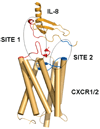Chemokine signaling specificity: essential role for the N-terminal domain of chemokine receptors
- PMID: 17630697
- PMCID: PMC2727729
- DOI: 10.1021/bi7004043
Chemokine signaling specificity: essential role for the N-terminal domain of chemokine receptors
Erratum in
- Biochemistry. 2007 Oct 16;46(41):11660
Abstract
Chemokine IL-8 (CXCL8) binds to its cognate receptors CXCR1 and CXCR2 to induce inflammatory responses, wound healing, tumorogenesis, and neuronal survival. Here we identify the N-loop residues in IL-8 (H18 and F21) and the receptor N-termini as the major structural determinants regulating the rate of receptor internalization, which in turn controlled the activation profile of ERK1/2, a central component of the receptor/ERK signaling pathway that dictates signal specificity. Our data further support the idea that the chemokine receptor core acts as a plastic scaffold. Thus, the diversity and intensity of inflammatory and noninflammatory responses mediated by chemokine receptors appear to be primarily determined by the initial interaction between the receptor N-terminus and the N-loop of chemokines.
Figures






Similar articles
-
Probing the role of CXC motif in chemokine CXCL8 for high affinity binding and activation of CXCR1 and CXCR2 receptors.J Biol Chem. 2010 Sep 17;285(38):29262-9. doi: 10.1074/jbc.M110.146555. Epub 2010 Jul 14. J Biol Chem. 2010. PMID: 20630874 Free PMC article.
-
Alpha-chemokine-mediated signal transduction in human Kaposi's sarcoma spindle cells.Biochim Biophys Acta. 2004 May 3;1691(2-3):129-39. doi: 10.1016/j.bbamcr.2004.01.002. Biochim Biophys Acta. 2004. PMID: 15110993
-
Rabbit neutrophil chemotactic protein (NCP) activates both CXCR1 and CXCR2 and is the functional homologue for human CXCL6.Biochem Pharmacol. 2004 Nov 15;68(10):1947-55. doi: 10.1016/j.bcp.2004.07.003. Biochem Pharmacol. 2004. PMID: 15476666
-
An updated review on the role of the CXCL8-CXCR1/2 axis in the progression and metastasis of breast cancer.Mol Biol Rep. 2021 Sep;48(9):6551-6561. doi: 10.1007/s11033-021-06648-8. Epub 2021 Aug 24. Mol Biol Rep. 2021. PMID: 34426905 Review.
-
ELR+ CXC chemokines and their receptors (CXC chemokine receptor 1 and CXC chemokine receptor 2) as new therapeutic targets.Pharmacol Ther. 2006 Oct;112(1):139-49. doi: 10.1016/j.pharmthera.2006.04.002. Epub 2006 May 23. Pharmacol Ther. 2006. PMID: 16720046 Review.
Cited by
-
Functional anatomy of the full-length CXCR4-CXCL12 complex systematically dissected by quantitative model-guided mutagenesis.Sci Signal. 2020 Jul 14;13(640):eaay5024. doi: 10.1126/scisignal.aay5024. Sci Signal. 2020. PMID: 32665413 Free PMC article.
-
In silico analysis reveals sequential interactions and protein conformational changes during the binding of chemokine CXCL-8 to its receptor CXCR1.PLoS One. 2014 Apr 4;9(4):e94178. doi: 10.1371/journal.pone.0094178. eCollection 2014. PLoS One. 2014. PMID: 24705928 Free PMC article.
-
Interactions of interleukin-8 with the human chemokine receptor CXCR1 in phospholipid bilayers by NMR spectroscopy.J Mol Biol. 2011 Nov 25;414(2):194-203. doi: 10.1016/j.jmb.2011.08.025. Epub 2011 Oct 12. J Mol Biol. 2011. PMID: 22019593 Free PMC article.
-
CCL28 chemokine: An anchoring point bridging innate and adaptive immunity.Int Immunopharmacol. 2017 Oct;51:165-170. doi: 10.1016/j.intimp.2017.08.012. Epub 2017 Aug 30. Int Immunopharmacol. 2017. PMID: 28843907 Free PMC article. Review.
-
Structural determinants of MIF functions in CXCR2-mediated inflammatory and atherogenic leukocyte recruitment.Proc Natl Acad Sci U S A. 2008 Oct 21;105(42):16278-83. doi: 10.1073/pnas.0804017105. Epub 2008 Oct 13. Proc Natl Acad Sci U S A. 2008. PMID: 18852457 Free PMC article.
References
-
- Baggiolini M. Chemokines and leukocyte traffic. Nature. 1998;392:565–568. - PubMed
-
- Onuffer JJ, Horuk R. Chemokines, chemokine receptors and small-molecule antagonists: Recent developments. Trends Pharmacol. Sci. 2002;23:459–467. - PubMed
-
- Thelen M. Dancing to the tune of chemokines. Nat. Immunol. 2001;2:129–134. - PubMed
-
- Ben-Baruch A, Bengali K, Tani K, Xu L, Oppenheim JJ, Wang JM. IL-8 and NAP-2 differ in their capacities to bind and chemoattract 293 cells transfected with either IL-8 receptor type A or type B. Cytokine. 1997;9:37–45. - PubMed
-
- Ben-Baruch A, Grimm M, Bengali K, Evans GA, Chertov O, Wang JM, Howard OM, Mukaida N, Matsushima K, Oppenheim JJ. The differential ability of IL-8 and neutrophil-activating peptide-2 to induce attenuation of chemotaxis is mediated by their divergent capabilities to phosphorylate CXCR2 (IL-8 receptor B) J. Immunol. 1997;158:5927–5933. - PubMed
Publication types
MeSH terms
Substances
Grants and funding
LinkOut - more resources
Full Text Sources
Miscellaneous

